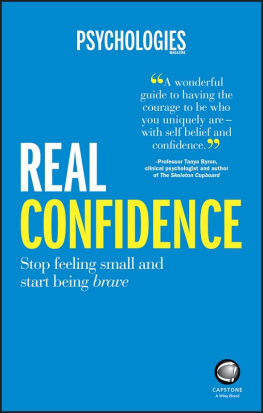
This book is challenging, thought provoking, and most of all practical. There are some great techniques, which, if you use them properly, will transform your outcomes, and give you significantly better results, whether in a business or personal context. This stuff just works!
Robi Bernberg, Chairman, Academy for Chief Executives
Success is never a one person operation success always needs cooperation and support. The fastest route to receiving that cooperation and support is to ask for it. Knowing who and when to ask is key. This book clearly demonstrates not just who and when but also why and how. An excellent read.
Kevin Gaskell, Entrepreneur, Chairman, Investor. Previous MD of Porsche GB Ltd and BMW GB Ltd
There are areas of everyones life in which it would help to be more influential yet information on how to make this happen has not been available in a way that everyone can access. Until now. Haider Imam is a genuinely good communicator who has taken this topic and brought it to life in a way that will be helpful to anyone wanting a greater degree of influence in some aspect of their life. This book combines content to provide the what and why and tools so that it is easy to understand the how. The authoritative sections on the brain are intriguing and fascinating and the tools are designed to inspire action.
Professor Patricia Riddell, Professor of Applied Neuroscience, Head of Department of Psychology, University of Reading
A compelling read and with many insightful and practical suggestions to help you excel in your personal and business lives.
Sir Peter Vardy DL, Chairman, Vardy Group of Companies
You can have everything in life you want if youll just help enough other people get what they want.
Zig Ziglar
2013 Haider Imam
Registered office
Capstone Publishing Ltd. (A Wiley Company), John Wiley and Sons Ltd, The Atrium, Southern Gate, Chichester, West Sussex, PO19 8SQ, United Kingdom.
For details of our global editorial offices, for customer services and for information about how to apply for permission to reuse the copyright material in this book please see our website at www.wiley.com.
The right of the author to be identified as the author of this work has been asserted in accordance with the Copyright, Designs and Patents Act 1988.
All rights reserved. No part of this publication may be reproduced, stored in a retrieval system, or transmitted, in any form or by any means, electronic, mechanical, photocopying, recording or otherwise, except as permitted by the UK Copyright, Designs and Patents Act 1988, without the prior permission of the publisher.
Wiley publishes in a variety of print and electronic formats and by print-on-demand. Some material included with standard print versions of this book may not be included in e-books or in print-on-demand. If this book refers to media such as a CD or DVD that is not included in the version you purchased, you may download this material at http://booksupport.wiley.com. For more information about Wiley products, visit www.wiley.com.
Designations used by companies to distinguish their products are often claimed as trademarks. All brand names and product names used in this book and on its cover are trade names, service marks, trademarks or registered trademarks of their respective owners. The publisher and the book are not associated with any product or vendor mentioned in this book. None of the companies referenced within the book have endorsed the book.
Limit of Liability/Disclaimer of Warranty: While the publisher and author have used their best efforts in preparing this book, they make no representations or warranties with respect to the accuracy or completeness of the contents of this book and specifically disclaim any implied warranties of merchantability or fitness for a particular purpose. It is sold on the understanding that the publisher is not engaged in rendering professional services and neither the publisher nor the author shall be liable for damages arising herefrom. If professional advice or other expert assistance is required, the services of a competent professional should be sought.
Library of Congress Cataloging-in-Publication Data
Imam, Haider, 1972
Straight to yes! : asking with confidence and getting what you want / Haider Imam.
p. cm.
Includes bibliographical references and index.
ISBN 978-0-85708-375-3 (pbk.)
1. Persuasion (Psychology) 2. Persuasion (Psychology) in organizations. I. Title.
BF637.P4I43 2013
153.8'52dc23
2012038295
A catalogue record for this book is available from the British Library.
ISBN 978-0-857-08375-3 (paperback) ISBN 978-0-857-08376-0 (ebk)
ISBN 978-0-857-08378-4 (ebk) ISBN 978-0-857-08377-7 (ebk)
Cover design: Binary & The Brain
Dedicated to
Marie-Claire, Laali and Omar my beloved and inspirational tribe.
And to the thinkers of great thoughts: the worlds greatest idea, without someone saying, Yes! to it, is as nothing. I sincerely hope this book unlocks possibilities, recognition and reward for you.
Introduction: Why Getting Straight to Yes! Is So Relevant Today
Theres an age-old Geordie saying from more austere times, which goes something like, Shy bairns get nae broth, meaning shy children dont get any soup. And its becoming truer in modern life. We live in an age of unparalleled competition for resources. At the time of writing there are seven people competing for every one university degree place in the UK. There is record unemployment in many parts of Europe, leading to intense competition to hold onto jobs or secure promotions. More than 40,000,000 people are using online dating in the US, all competing for the same hearts. Across the world, famous brand name businesses have closed down their doors because of recession and insufficient sales to turn them around. Undeniably, these are challenging times.
So, congratulations! What youre in possession of and reading right now is undeniably an exciting and enticing prospect: the ability to fine-tune your game to make a measurable and noticeable impact with your target audience. The content contained within has been proven effective in multiple business models across multiple industries, cultures and continents. However, before we get into the main flow of the book, Id like to offer some personalized thoughts for you on why this collection of short, simple, practical techniques is so relevant to you.
An Evolving Business Paradigm
Business leaders around the globe are struggling to cope with the break-neck pace of change in their markets and consumer buying patterns. Micro-financing, neuromarketing and social networking are just three examples of how our world is becoming more opportunistic, sophisticated and connected. Perhaps most challenging of all is the demise of authority as a main source of influence. Since the swinging 60s, attitudes to authority figures have been evolving rapidly. Now the ageing baby boomers that masterminded this shift are tasting the fruits of their labour courtesy of Generation Y (also known as the Millennials ). Gen Y, as a generalization, attributes far less clout to rank and file than previous generations: its a generation that wants to be enfranchised, included in the planning and wooed to join in. It likes autonomy and flat organizations. It likes Twitter and Facebook. It dislikes hierarchy and red tape. Its preference is to deliver change through people not to people.
Add to Gen Y the reality of a global labour market: a modern leader of a multinational corporation may contend with offices across the world and a call centre in Mumbai with contrasting cultural attitudes, but even the leaders of a small business may have a dozen different nationalities and cultures working in their very own office. Using the same old management, leadership and influence approaches from yesteryear with this new workforce demographic is a recipe for disaster. If we abuse them, we lose them, which will damage our results and our reputation. The fact is that in todays marketplace, job loyalty is rare. Many executives I know keep their details on job hunt sites or headhunters lists because theyre always looking for that next step up the career ladder. The crumbling paradigm of a job for life is rapidly being replaced by multiple careers, micro-businesses, joint ventures and an entrepreneurial revolution. Even some of the major organizations my company works with engage us specifically to help their leaders become more entrepreneurial. Losing good people is exactly what you dont need when you feel youre constantly under scrutiny, while attempting to deliver more with fewer resources.
Next page










